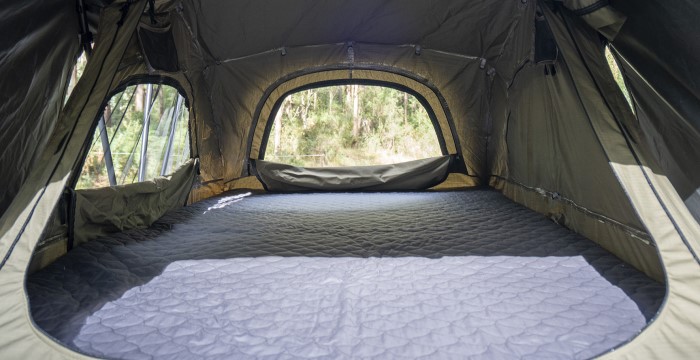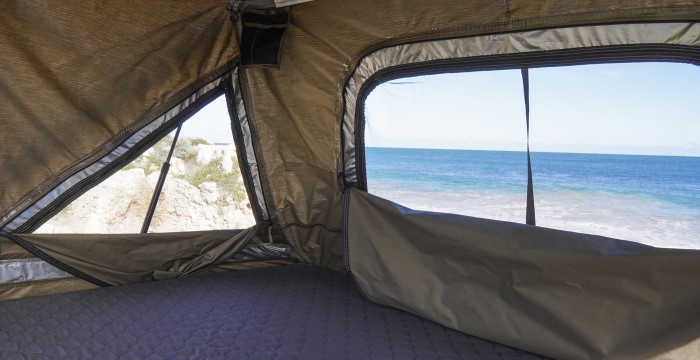| Your browser is not supported. | ||
|
Please browse our site using any of the following options:
| ||
How To Prevent Condensation In A Roof Top Tent

When camping in the outback, condensation in a roof top tent can quickly become any camper's worst enemy. The way tent condensation is created inside of your tent all boils down to your breathing. Because our internal body temperature sits around 37°C, we warm the air we inhale, resulting in exhaling warm air - which can quickly become a problem inside of a rooftop tent during cold weather as the warm water vapour in our breath turns into condensation on the inside walls of the tent. So is the solution to simply stop breathing? Nope, luckily there is a much easier way by reading our helpful guide on how to stop condensation in a tent.
Quick Links
- How To Stop Condensation In A Roof Top Tent
- How To Keep Condensation Out Of A Roof Top Tent In Winter
How To Stop Condensation In A Tent
Keep Clear Airflow and Ensure Ventilation
Ensuring proper airflow in a roof top tent is crucial to prevent condensation, which occurs when warm, moist air from breathing meets cold surfaces. By keeping all the windows partially open, you ensure proper ventilation and allow the humid air to escape and fresh air to circulate. This balance reduces moisture buildup, maintaining a dry and comfortable environment inside the tent. This is why both the Dune 4WD Nomad 140cm Deluxe Hardtop Roof Top Tent and Dune 4WD Nomad 140cm Lite Roof Top Tent feature an ultra-fine mesh fly screen that effectively keeps tiny insects out while allowing for optimal airflow. Their large windows provide a 360° view, which enhances airflow while providing incredible views of your surroundings. Their covered vents on either side of the entry also ensure continuous airflow to reduce condensation. Our Dune 4WD Nomad 130cm Compact Lite Roof Top Tent also features a fly screen that is designed with an ultra-fine mesh for keeping out unwanted insects and providing the right amount of airflow, along with a 360° view thanks to its large windows while maximising airflow.
Keep Wet Clothing Outside
Keeping wet clothes outside of your roof top tent is crucial to stop condensation in a tent. Wet clothing releases moisture into the air as it dries, increasing humidity levels inside your tent. By storing damp clothing outside, you prevent this additional moisture from contributing to condensation on the tent's interior surfaces. This helps maintain a drier environment, minimising the risk of mould and mildew buildup. It also preserves the roof top tent's insulation efficiency, ensuring a more stable internal temperature and improving the tent's ventilation effectiveness in managing humidity.
How To Keep Condensation Out Of A Roof Top Tent In Winter
Camp In The Shade
Setting up a roof top tent in the shade during winter helps manage condensation by leveraging the warmer, more stable temperature under shaded areas. For the best results, choose a camping spot near a large, shady tree. The shaded environment typically maintains a warmer microclimate compared to exposed, open areas where cold winds can increase humidity levels. Large trees provide natural insulation, reducing the temperature differential between the tent's interior and exterior, which minimises condensation. This is why camping next to a tree can ensure a more comfortable and dry roof top tent environment, effectively managing moisture and enhancing your overall comfort.
Camp On Higher Terrain
Camping on higher terrain is another effective method when it comes to how to keep condensation out of a tent in winter because cold air naturally settles in low-lying areas and worsens condensation when it contacts the warmer tent exterior walls. By camping on elevated ground, you benefit from the natural rise of warmer air, which minimises the risk of cold air pooling around your tent. This elevated position helps maintain a more balanced temperature inside your roof top tent, reducing the temperature differential and limiting condensation. This is why camping on higher ground in winter ensures a drier, more comfortable environment to help manage moisture buildup more effectively.
Always Dry Your Tent Properly
To prevent mould inside of your roof top tent due to condensation, it's crucial to thoroughly dry your tent. This is why it is crucial to always wipe down all moisture from your tent with a microfiber towel, like our Denali Suede Microfibre Travel Towel, to remove as much excess water as you can. Once you've finished wiping it down, set up your roof top tent on a sunny day to fully dry it out. The sunlight and airflow will help evaporate any remaining moisture, preventing mould growth and ensuring a fresh and clean roof top tent. Regular drying reduces the risk of mould and preserves the tent's fabric.
Find The Best Rooftop Tents At Anaconda Today
Don't let condensation ruin your camping trip - follow these simple steps for how to stop condensation in a tent and make sure you have the best tent possible by exploring our full range of roof top tents at Anaconda. Ensure you also check out our Adventure Centre for more helpful tips and exciting destinations that you can visit with your friends, loved ones and family. If you liked our How To Prevent Condensation In Roof Top Tent article, then you might also like some of our other articles for awesome destinations and tips such as:
- Roof Top Tents Buying Guide
- Dune 4WD Roof Top Tent Review & Features
- Roof Top Tents Vs Ground Tents: Which One To Choose
- Why Roof Top Tents Are A Game-Changer For Camping
- How To Clean & Care For Your Roof Top Tent
Find your local Anaconda store and check out our amazing roof top tent range for your next outdoor adventure



